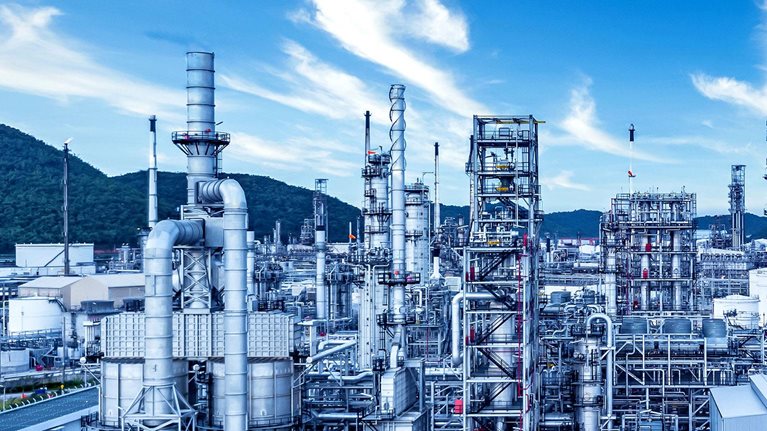For the petrochemical industry, the past three years have been marked by disruption and volatility. In 2020, the outbreak of COVID-19 led to increased demand for household goods and consumer products, and petrochemicals proved remarkably resilient. In 2021, rising commodity prices and supply chain disruption resulted in record performance as well as a growing number of sustainability partnerships and commitments, particularly in recycling. And in the past year, petrochemicals value creation was affected by the war in Ukraine, global inflation, and the risk of recession—all while the world continued to recover from the worst of the pandemic.
Looking back
In 2022, four themes rose to prominence: eased supply chain constraints, regional disparities, natural gas–linked chemicals volatility, and sustainability acceleration.
Eased supply chain constraints reduced regional profit pools
Petrochemical companies earned record-high revenues and profits in 2021, as well as in the first half of 2022 (Exhibit 1). This was driven by strong demand recovery from COVID-19, supply chain constraints from container shipping, and tight markets linked to production disruptions caused by a major winter storm in early 2021, all of which led to relatively high prices and margins. In Asia, prices for many chemicals were decoupled from the West, driven by logistical challenges in container shipping.

In the second half of 2022, however, profits began to return to pre-COVID-19 levels. A major reason for this return to “normal” is that supply chain constraints began easing at the beginning of the third quarter of 2022 as fleet capacity increased and global demand for consumer goods waned. As a result, congestion across the logistics value chain also began to ease, leading to price differentials for some petrochemicals, such as polyethylene (PE) and polypropylene (PP), returning to previously observed market behavior.
In North America, crackers with advantaged gas-based feedstocks, such as ethane, generated historic high margins in 2021; those margins declined in 2022 as polymer prices approached parity with Asia again as trade constraints were resolved. The price differential for high-density polyethylene (HDPE) between China and North America declined from more than $700 per ton in the second half of 2021 to almost parity today, and the price differential for PP declined from more than $700 per ton in the second half of 2021 to around $200 per ton today. In Europe, the polymer margin spike in 2021 also reverted to historical levels.
Regional overcapacity and relatively low growth in Asia put pressure on margins
Differences in regional circumstances persisted from 2021 to 2022. Although the high profits in North America and Western Europe have normalized to lower levels, the petrochemical industry in Asia has remained a challenge. Elevated oil and gas prices, as well as decreased demand in China, led to historic low margins1 in Asia and reduced operating rates.
Relatively slow economic growth in Asia continued to affect profitability. Zero-tolerance measures for COVID-19 in China were one factor, which contributed to the contraction of manufacturing activities in China and lower-than-expected petrochemical demand. And decreased demand growth put downward pressure on crucial petrochemical product prices. On the supply side, several large-scale chemical projects, generally integrated crackers and derivatives units—most years in the making—came online in 2022. As a result, some Asian players cut operating rates.
Gas and power supply and prices in Europe strongly affected
The invasion of Ukraine in February 2022 has had a profound impact on the lives and livelihoods of millions of people, leading to heightened fears of an economic recession and food shortages, among other things. In turn, the impact on global petrochemicals has been significant. This is especially true for natural gas–based chemicals in Europe that have experienced strong increases in production cost, affecting regional competitiveness and consequently sourcing of product.
Competitiveness of gas-based chemicals. In mid-2022, the price of gas in Europe skyrocketed from an average of less than $20 per million British thermal units (MMBTU) to more than $70 per MMBTU, leading to significant cost inflation for petrochemicals, especially those that use natural gas as feedstock. In Europe during this time, the prices of ammonia and urea spiked by 130 to 140 percent, compared with the beginning of 2022.
Sourcing of gas-linked chemicals. The reduction of the gas supply in Europe led to significant shutdowns as well as reduced production for gas-linked chemicals such as ammonia and methanol (Exhibit 2). The region’s operating rates of ammonia decreased by 35 percent for ammonia in 2022, compared with rates in 2020. Similarly, the methanol operation rate was reduced by 20 percent. And the availability of gas-linked chemicals was challenged by reduced exports from Russia, especially those used in fertilizers, such as ammonia and urea.

A new wave of investments is accelerating sustainability
Last year saw the growing momentum of decarbonization, with more than 90 percent of the top 25 chemical companies announcing carbon-neutral or net-zero targets, up from 50 percent in 2021. In addition, projections show accelerated progress on the supply side for circular products (Exhibit 3).

Increased consumer options and commitments. New rules around packaging, such as the recent EU legislation on packaging and packaging waste, are raising targets for recycled content in plastic packaging.2 Progress by consumer-packaged-goods companies (CPGs) in achieving high-recycled-content goals has been incremental over the past year, but bridging the gap between today and 2025 will require significant changes. For CPGs, average recycled content creeped upward from 7 to 9 percent from 2020 to 2021; the typical recycled-content commitment with the Ellen MacArthur Foundation will reach 25 percent by 2025.3
Emphasis on commercial-scale developments. Several polyolefin players are investing in feedstock recycling, via pyrolysis, at increasing scale. In addition, the first announcements in advanced recycling on a global scale were made around polyethylene terephthalate (PET) monomer recycling, as well as growing investment in PET fiber (monomer) recycling.
Collaboration across the value chain. New relationships have formed among waste haulers, recyclers, and petrochemical producers for both mechanical and advanced recycling.4 There is also growing recognition that value chain collaboration can help expand available feedstock, especially for hard-to-recycle plastics such as films.
Looking ahead
We believe that the most successful petrochemical companies will focus on three strategic topics in 2023:
- Managing high cost and volatility. 2023 will likely be just as volatile as 2021–22. Facing difficulties in the macroeconomic environment and extended geopolitical uncertainties, chemical players will not only need to tighten investment discipline but also consider important measures to improve resilience. On this point, chemical companies can learn from the measures top players took in response to COVID-19,5 including streamlining their product portfolio, expanding into higher-margin or growth (specialty) products, and rationalizing capacities for underperforming assets. In addition, tapping into demand centers in emerging markets, such as India and Indonesia, could also be an option. That said, one lesson of the past few years is that export-driven growth is enabled by more than just advantaged feedstock; it also requires ensuring supply chain reliability with sourcing resilience.
- Staying the course on decarbonization and circularity. Over the past two years, there has been consistent, measured progress throughout the industry in sustainability commitments and actions. However, the market is evolving rapidly with a wide range of potential sustainable solutions, such as circularity, carbon capture, bio-based chemicals, and renewable power, each with various states of technological maturity, availability of resources, capital intensity, supply chain requirements, and environment impacts. Thus, it will be important for players to develop a credible portfolio of selective solutions that best fit the business footprint and are consistent with a long-term sustainable pathway.
- Looking for M&A opportunities. With recent declines in petrochemicals margins, there may be opportunities for acquisitions. Strategies such as end-to-end digitalization and operational excellence, coupled with good execution, can help drive synergies. Furthermore, end-market and supply chain overlap as well as economies of scale can offer strategic rationale, value creation options, and improved resilience for combined organizations over the long term.
Petrochemical companies around the world need to get ready for a more challenging and uncertain period ahead. Future winners will not only take steps to play defense but also decide on where to place bets in the future to capture the new round of value-creating opportunities coming into view.

